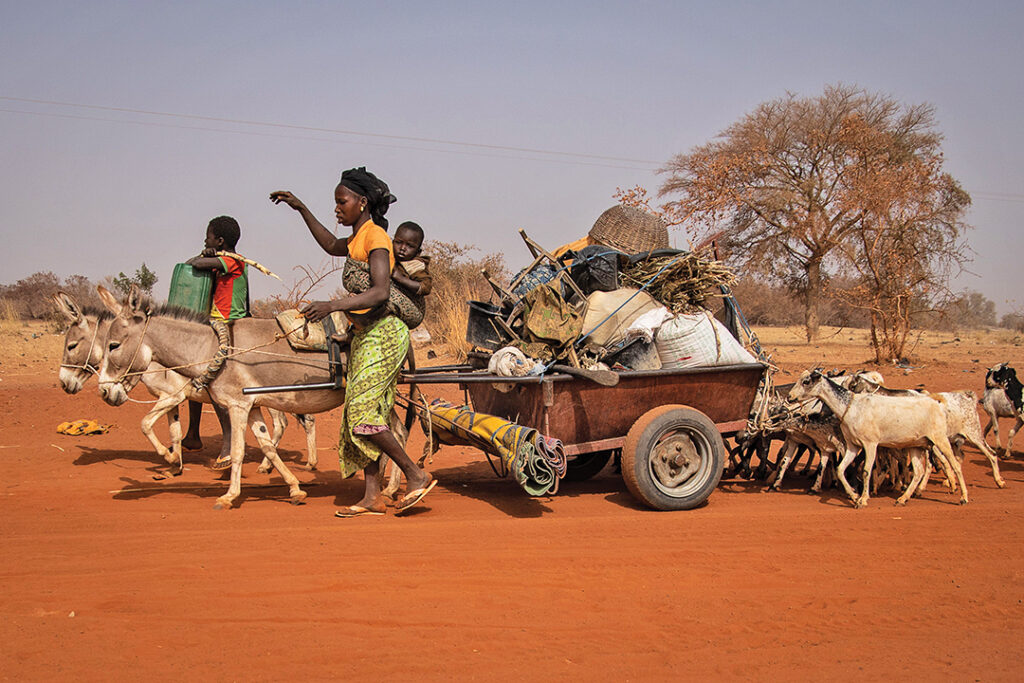ADF STAFF | Photos by AFP/Getty Images
Mass atrocities, forced displacement, public executions: Terror. It has been a fact of life in parts of Africa’s Sahel region since extremists gained a foothold in Mali in 2012 and then spread their reach beyond its borders.
Despite efforts by regional security forces and global partners, the violence shows no sign of stopping. By the end of 2021, there was an 18% increase in violent events and a 14% decrease in fatalities compared to the record-setting violence of 2020 in the Sahel, according to the Armed Conflict Location & Event Data Project (ACLED), which documents violence across the globe.
Much of the violence was attributed to the al-Qaida-affiliated Jama’at Nusrat al-Islam wal-Muslimin (JNIM) coalition of militant Islamist groups, including the Macina Liberation Front (FLM), which originated in central Mali. The Islamic State in the Greater Sahara (ISGS) also is active.
Fatalities linked to JNIM in 2021 were expected to increase over 2020. By the end of June 2021, reported fatalities attributed to FLM through battles with security forces and other militant groups already had passed their 2020 level and were on track to double.

In Burkina Faso, Mali and Niger, military pressure had forced ISGS and JNIM from some areas, but the groups continued committing atrocities in more remote locations, sometimes spilling into neighboring countries and occasionally battling each other.
Other terrorist groups operating in the Sahel include Ansar al-Dine, established in 2011 by Iyad Ag Ghali, the central leader of the 1990 rebellion in Mali, and Ansaroul Islam, considered Burkina Faso’s first Islamist terror group.
The number of militants killed in Burkina Faso, Mali and Niger during offensive military operations from early 2020 through mid-June 2021 was estimated at more than 1,400, according to ACLED.
Mali Remains Fragile
Insurgencies often thrive in areas of political upheaval. This has been the case in Mali where, in June 2021, the country experienced its second military coup in nine months. Repeated JNIM and ISGS attacks on Malian forces through the first half of the year only made the country’s security situation worse.
The first half of 2021 was deadly for Malian forces. JNIM killed 10 Soldiers in February during an ambush in the southern-central town of Boni, and ISGS attacked a convoy in the eastern town of Tessit in March, killing at least 33 troops.
In December 2020, a European effort called Task Force Takuba arrived in northern Mali with the first troops coming from France and Estonia; Czech and Swedish forces arrived soon thereafter, according to the Council on Foreign Relations.
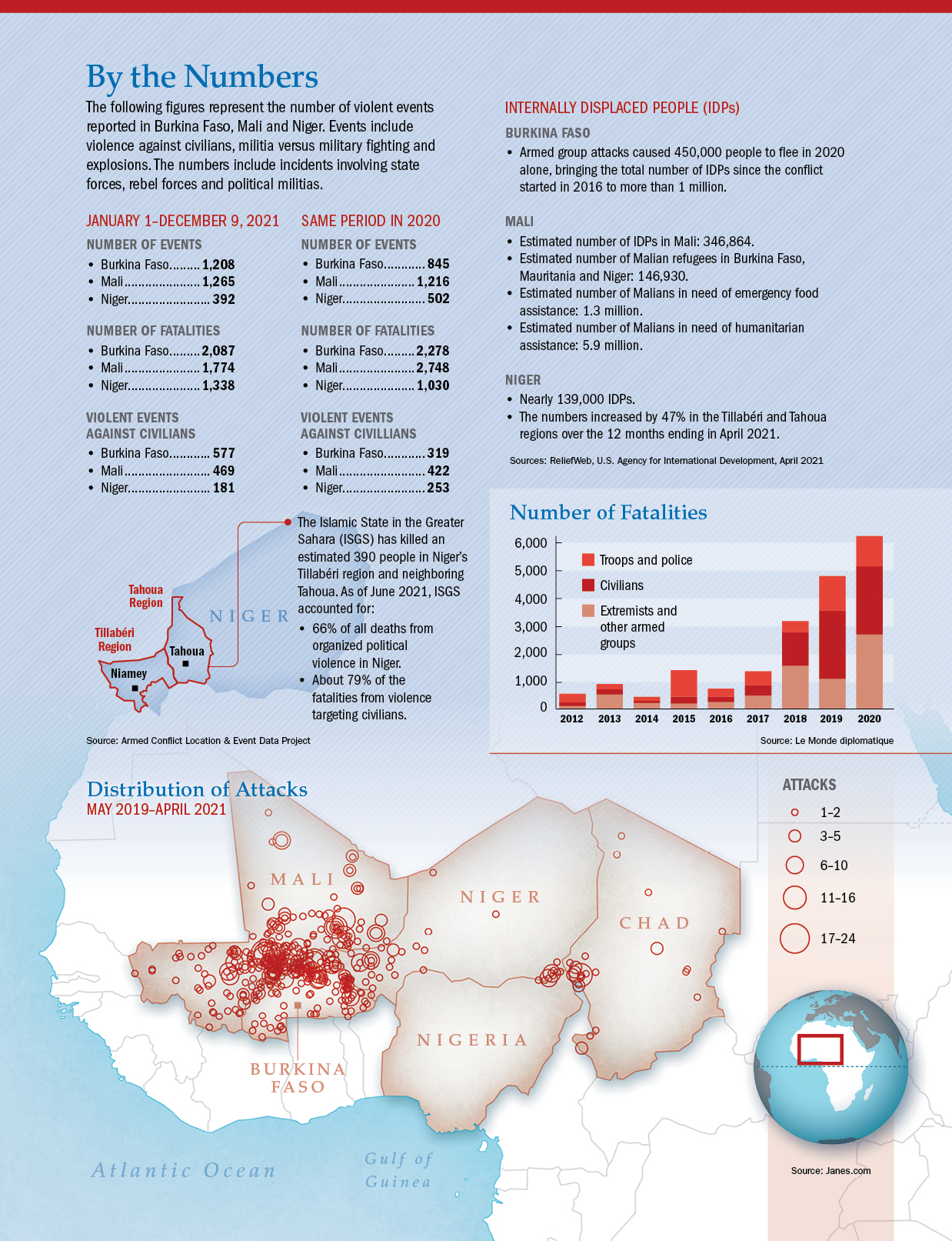 French President Emmanuel Macron in July 2021 announced that he would end Operation Barkhane, which began after France initiated a military intervention in 2013. Macron also closed three military bases in Mali and reduced by half the number of French troops in the Sahel.
French President Emmanuel Macron in July 2021 announced that he would end Operation Barkhane, which began after France initiated a military intervention in 2013. Macron also closed three military bases in Mali and reduced by half the number of French troops in the Sahel.
Other international security operations in Mali since 2013 include the United Nations Multidimensional Integrated Stabilization Mission in Mali, which has supported political processes and performed security-related duties, and the European Union Training Mission Mali (EUTM), which works to strengthen the Malian Armed Forces.
By October 2021, Mali reportedly was close to reaching a deal that would deploy 1,000 members of Russia’s Wagner Group to the country to counter terrorism and insecurity. The notoriously brutal mercenaries operate in several countries on the continent and have a track record of human rights abuses and self-enrichment.
ISGS in Niger
In Niger, the Tillabéri region continued to be a hot spot for attacks by ISGS, JNIM and armed bandits.
In January 2021, jihadist gunmen killed 100 people in Tchoma Bangou and Zaroumadareye. The villages are about 120 kilometers north of Niger’s capital, Niamey, in the Tillabéri region that borders Mali and Burkina Faso.
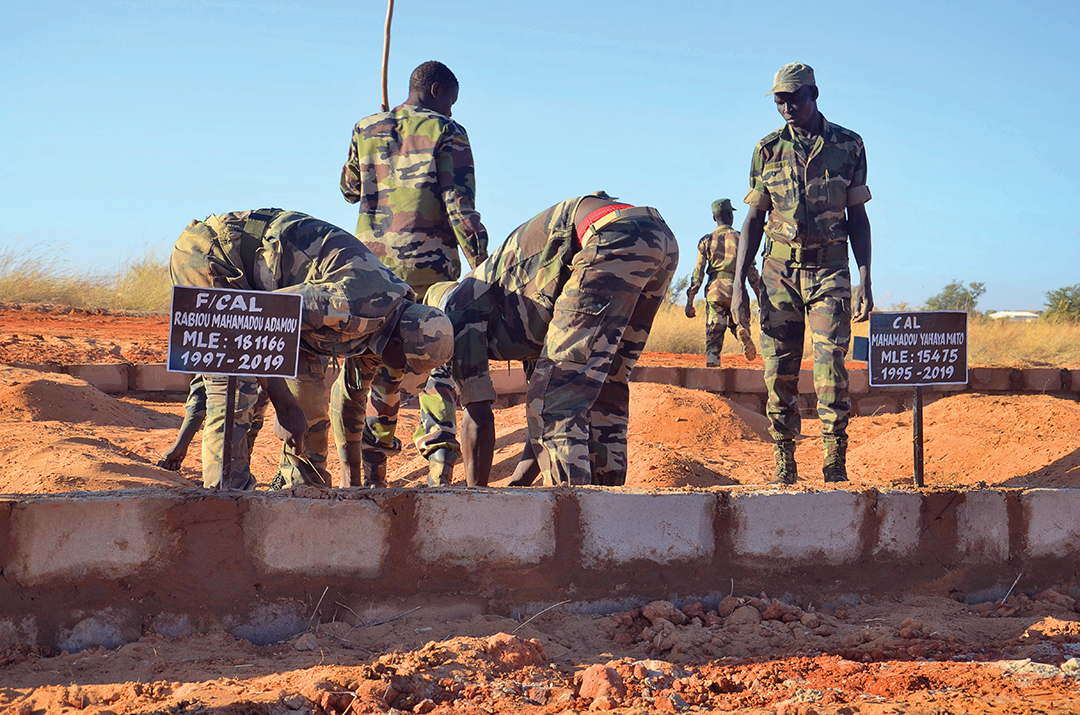
In a public meeting of federal, regional and local leaders in the town of Ouallam, Gen. Mahamadou Abou Tarka said Tillabéri’s border with Mali allows extremists virtually unfettered access to the region.
“The difficulties of guaranteeing peace in an area like that of northern Tillabéri comes from the fact that it is a border area open to Mali, where the government has unfortunately disappeared,” said Tarka, who serves as president of Niger’s High Authority for the Consolidation of Peace. “We must seek them out, pursue them relentlessly in their base in Mali, annihilate them, deny them the ground.”
To win this battle against extremism, he said, the military, local leadership and the public must work hand in hand.
“The Armed Forces need the knowledge that the administration has of communities,” he said. “Consultation between the military and the governor, between the military and the prefects, must be permanent.”
ISGS is by far the most active terrorist group in Niger. In the first half of 2021, the number of people ISGS killed accounted for 66% of all deaths from organized political violence and about 79% of the fatalities from violence targeting civilians, according to ACLED.
Brutality in Burkina Faso
ISGS also has left a trail of devastation in Burkina Faso, where the terrorists are known to cut off the hands of suspected thieves, perform public executions and recruit children. Since 2018, the country has experienced a sharp increase in attacks against security forces and civilians.
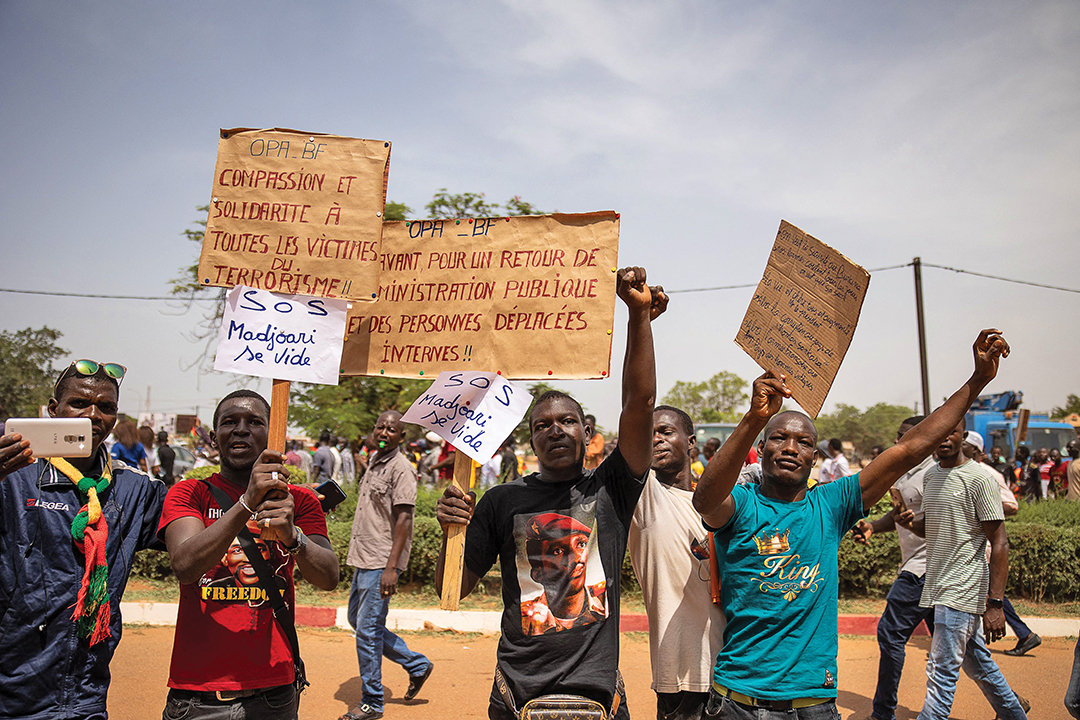
On June 4, 2021, gunmen, mostly children ages 12 to 14, raided the village of Solhan in northeast Burkina Faso, killing more than 160 people and burning homes.
Fighting between ISGS and JNIM, along with the efforts of French and G5 Sahel Joint Force security forces, has weakened ISGS in the country’s Sahel, Centre-Nord and Est regions. The group has switched operations to the Seno province in southern Burkina Faso and the eastern Oudalan province.
JNIM attempts to maintain compliance and regulate social conduct through less deadly means, including intimidation through threats, beatings and kidnappings in areas the group controls, according to ACLED.
In November 2020, however, JNIM responded to the deployment of troops in the northeastern town of Mansila by imposing an embargo on the town and placing improvised explosive devices along surrounding roads.
Through the first half of 2021, extremist groups killed 66 volunteer militiamen, and, in November, an attack near a gold mine in Inata killed 49 military police.
As of May 2021, more than 1.1 million Burkinabe civilians were internally displaced, compared with 560,000 at the beginning of 2020, according to the U.S. Agency for International Development.
Islamic State Franchises Multiply
Years After Losing Territory in the Middle East, ISIS Proliferates on the African Continent
ADF STAFF
The Islamic State group, which once held about a third of Syrian territory and even more ground in Iraq, now oversees a network of affiliates of varying sizes across Africa.
Each affiliate arose in disparate regions with unique histories and grievances. Groups exploiting those grievances through extortion and violence eventually took on the brand known globally as ISIS. Now the international community is joining African nations in looking for ways to combat the spread.
Islamic State group influence in Africa has grown yearly since 2014, according to a 2021 Sky News report. By 2019, at least 22 African countries had seen suspected Islamic State group-linked activity, even if no affiliate was based there. By 2020, eight countries had seen an increase in such violence. Those eight represent West Africa’s Sahel, the current epicenter of Islamic State group violence on the continent, and the Democratic Republic of the Congo (DRC) and Mozambique.
Observers say the Islamic State group affiliations offer advantages to Africa-based militant groups and the umbrella organization. Local jihadist groups gain the cachet “of the Islamic State brand as well as the resources that come along it, such as financing, training, and a worldwide social media-based propaganda platform,” wrote Jacob Zenn, of the Jamestown Foundation, and Colin P. Clarke, of the Soufan Group, for Foreign Policy magazine. In turn, the Islamic State group can point to successes in Africa as it struggles to recover from defeats in the Middle East.
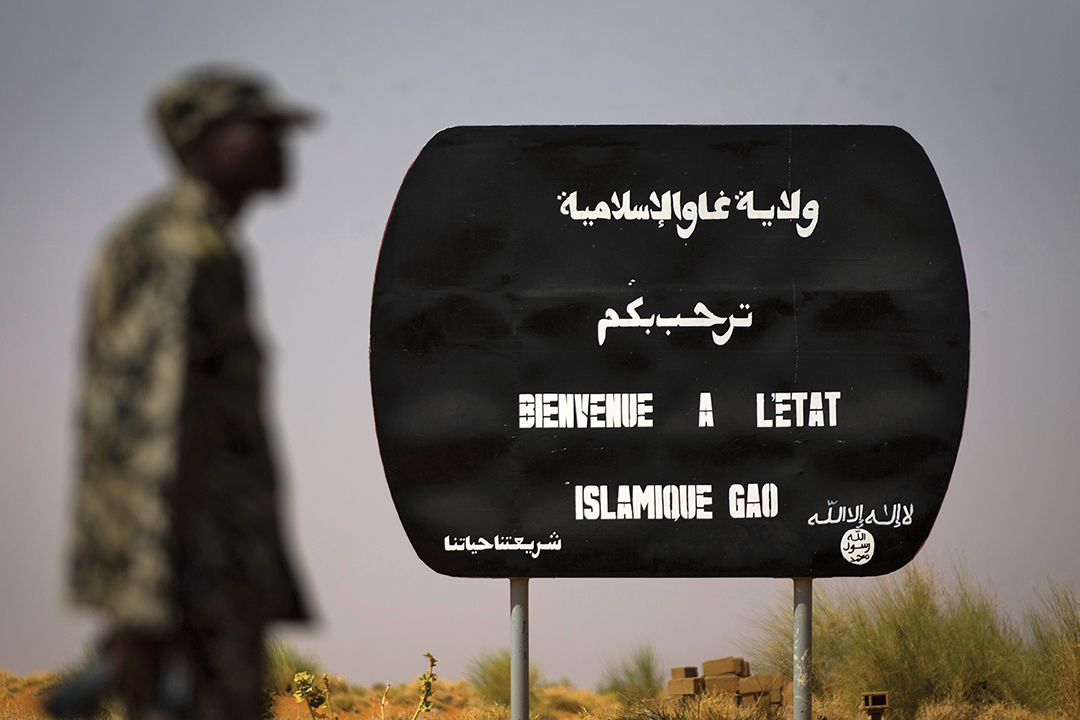
In fact, African affiliates now are featured on the front page of the Islamic State group’s weekly publication, al-Naba, more than core groups in Iraq and Syria (ISIS core), Zenn and Clarke reported.
There are six African affiliates, or provinces, of the Islamic State group in Africa. The first three began in 2014 in war-torn Libya, Algeria and Egypt’s troubled Sinai region. A year later, Islamic State West Africa Province (ISWAP) formed and has branches in the Lake Chad Basin and the Sahel. One branch emerged from Nigeria’s Boko Haram insurgency and the other out of militant groups active in northern Mali.
A small group in Somalia pledged allegiance to the Islamic State group in 2018, and a year later Islamic State Central Africa Province formed. It has branches in Mozambique’s Cabo Delgado province insurgency and in a faction of the eastern DRC’s Allied Democratic Forces militant group.
“Underscoring how important an area of operations Africa has become for the Islamic State, an estimated 41 percent of all global deaths inflicted by Islamic State militants in 2019 occurred in Africa,” researchers Tricia Bacon and Jason Warner for the Combating Terrorism Center at West Point wrote.
The African groups vary by history, size and motivation. Experts have found that discerning the true relationships between them and the Islamic State group can be elusive. Ultimately, the Islamic State group has to designate a group as a province for it to be considered an affiliate.
Researchers Haroro J. Ingram and Lorenzo Vidino in a May 2021 essay for Lawfare, a blog of the Lawfare Institute, wrote that the Islamic State group supplies affiliates with its aqeeda (creed) and manhaj (method) for establishing an Islamic state and a brand for furthering its propaganda.
“In short, its affiliates are expected to adopt and apply the Islamic State’s ideology and politico-military strategy in their corner of the world,” they wrote.
For example, in the DRC, Seka Musa Baluku’s faction of the Allied Democratic Forces militant group has adopted ISIS core propaganda techniques and talking points. In turn, Ingram and Vidino wrote, the Islamic State group has acknowledged the DRC militants’ operations and claimed its successes. ISIS core doesn’t seem to be doing much toward command and control, but there is evidence of funding coming to the DRC group.
One theme that unites the affiliates is their “mutual commitment to the ideals, at least ostensibly, of a global caliphate,” according to Bacon and Warner.
In the way of aid to the Libyan group, ISIS core sent emissaries from Iraq, returned foreign fighters to bolster local forces, offered money, and supplied governance, tactical and strategic advice.
ISIS core also has sent money to ISWAP’s Lake Chad faction and to groups in Somalia. Money and weapons went to the Sinai group, Bacon and Warner wrote. Even so, aid to affiliates was “ad hoc and infrequent.”
Zenn and Clarke argued that Libyan provinces, which are more or less defunct now, represented a first-degree connection because they pledged loyalty, took in fighters from Syria to establish themselves, and “maintained frequent and direct communications to the group’s core.” They also got funding, training and advice until international and Libyan forces dislodged them.
ISWAP would represent a second-tier connection. It has pledged loyalty but has had little engagement with fighters and trainers from the ISIS core group. ISIS does, however, promote attacks and consult with ISWAP leaders.
The world is taking note of the Islamic State group’s growth in Africa. In late June 2021, leaders with the 83-nation Global Coalition to Defeat ISIS met in Rome and approved a task force to address the militant group’s spread into Africa.
Luigi Di Maio, Italian minister of Foreign Affairs, did not share details about how the task force would work, but he said a “holistic approach” is needed to address poverty and other drivers of extremism.
The coalition announced that the Central African Republic, the DRC and Mauritania are among the group’s newest members. Burkina Faso, Ghana and Mozambique attended as observers.
“While it is good that the coalition is talking about Africa and bringing relevant countries into the discussion, any coordination seems to be still in the early stages, while the conditions on the ground are deteriorating very fast,” Emily Estelle, a research fellow at the American Enterprise Institute, told Voice of America.
“The proposed task force should focus its energy on backing up military success with governance success,” she said. “This is the gap that lets IS and other groups keep coming back after military losses.”
International Military Efforts
United Nations Multidimensional Integrated Stabilization Mission in Mali (MINUSMA)
MINUSMA, established in 2013, is authorized to include 13,289 military personnel and 1,920 police officers. Its forces are spread across five sectors. Its mandate includes supporting the implementation of a peace agreement in Mali and helping Malian stakeholders devise a strategy to protect civilians and reduce violence. During much of its existence it has been the most dangerous peacekeeping mission in the world with 260 peacekeepers killed as of November 2021.
G5 Sahel Joint Force
Authorities formed the G5 Sahel Joint Force in 2017 as a military alliance among Burkina Faso, Chad, Mali, Mauritania and Niger. At its creation it was authorized by the African Union and the U.N. Headquartered in Bamako, Mali, it includes up to 5,000 personnel, including Soldiers, police and gendarmes. It addresses terrorism, drug trafficking and human trafficking in the Sahel with a particular emphasis on border regions between member countries.
Multinational Joint Task Force (MNJTF)
Officials established the MNJTF in 1994 in Nigeria in response to armed banditry in the Lake Chad basin. In 1998, it became truly multinational with the inclusion of Chad and Niger, which were experiencing similar security challenges. In 2015, as the extremist group Boko Haram spread throughout the region, the African Union authorized the deployment of about 10,000 troops to address the security crisis. It now includes five member states — Benin, Cameroon, Chad, Niger and Nigeria — with four sectors headquartered in Mora, Cameroon; Baga-Sola, Chad; Baga, Nigeria; and Diffa, Niger.
European Union Training Mission (EUTM) Mali
The mission, which began in 2013, is made up of more than 800 Soldiers from 22 EU members and five nonmember states. EUTM Mali trains and advises the Malian military, improves the military education system, and advises G5 Sahel Joint Force headquarters personnel. It began its fifth mandate in 2020 and, as of mid-2021, had trained more than 15,000 Malian Armed Forces students in a variety of skills including first aid, countering improvised explosive devices and human rights law.
Operation Barkhane
This French-led military intervention came after Operation Serval in August 2014. Unlike Serval, which was limited to Mali, Barkhane was designed to respond to militants across the Sahel with a particular emphasis on the tri-border region between Burkina Faso, Mali and Niger. Up to 4,500 Soldiers were deployed in Burkina Faso, Chad, Mali and Niger with headquarters in N’Djamena, Chad. In July 2021, French President Emmanuel Macron announced that he would end the operation while continuing French support for countries in the region fighting extremism.
Task Force Takuba
In December 2020, a European effort called Task Force Takuba arrived in northern Mali with the first troops coming from France and Estonia; Czech and Swedish forces arrived soon thereafter, according to the Council on Foreign Relations. In 2021, the task force brought together the special forces from seven European countries to fight terrorism in the Sahel. The force includes 600 troops, half of whom are from the French Army.
Armed Groups
Jama’at Nusrat al-Islam wal-Muslimin (JNIM)
JNIM formed in March 2017 through the merger of four jihadist groups in the Sahel: Ansar al-Dine, the Macina Liberation Front, al-Mourabitoun and the Sahara branch of al-Qaida in the Islamic Maghreb (AQIM). Since then, it has expanded its operating territory across West Africa while committing violence against civilians, local security forces, international militaries and U.N. peacekeepers.
Ansar al-Dine
Ansar al-Dine, which means “Defenders of the Faith,” is an Islamic Tuareg group founded in December 2011. The group has tried to establish Shariah across Mali and often targets western civilians and peacekeepers. The group was heavily involved in Mali’s 2012 coup. In 2017, the group officially merged with the Macina Liberation Front, al-Mourabitoun, and the Sahara branch of AQIM to form JNIM.
Macina Liberation Front (FLM)
An affiliate of Ansar al-Dine, the FLM formed in January 2015 with the goal of taking over a large territory in central Mali and substituting itself for the Malian state. It was founded by Amadou Koufa, a radical Fulani preacher from the Mopti region. The group initially attacked Malian troops but soon began targeting civilians, conducting small-scale raids on police stations and assassinating local officials. The group reportedly used improvised explosive devices, car bombs and suicide attacks during an attack against the G5 Sahel’s Joint Force headquarters in 2018.
Islamic State in the Greater Sahara (ISGS)
Operating in the Sahel’s Liptako-Gourma region along the borders of Burkina Faso, Mali and Niger, the ISGS aims to establish Salafi-jihadist rule. The group is known for competing with other terrorist groups, committing violence against civilians, and attacking local and international security forces. In September 2021, French troops killed ISGS head Adnan Abu Walid al-Sahrawi, who was wanted for deadly attacks on U.S. Soldiers and foreign aid workers.
Ansaroul Islam
Founded in 2016 by Ibrahim Malam Dicko, a Fulani imam and preacher, Ansaroul Islam is considered to be Burkina Faso’s first homegrown militant Islamist group. The group splintered after Dicko was killed in a French-led raid of his camp in 2017. From 2016 to 2018, just more than half of militant Islamist violent events in Burkina Faso were attributed to Ansaroul Islam, but the group’s activities declined sharply in the following years.

